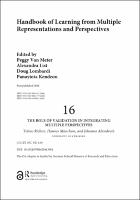Chapter 16 The Role of Validation in Integrating Multiple Perspectives
Proposal review
Author(s)
Richter, Tobias
Münchow, Hannes
Abendroth, Johanna
Language
EnglishAbstract
The internet is the primary source of information about a broad range of topics, which may range from consumer and medical decisions to political and socio-scientific issues. The relevant information is often available in the form of written texts that convey divergent perspectives, such as different opinions, competing theoretical assumptions, arguments and counterarguments, and evidence and counterevidence. What are the challenges and potential problems associated with comprehending texts that convey multiple perspectives? How can students be supported to make the most of this obviously complicated reading situation? This chapter attempts to answer these questions from a particular theoretical perspective that revolves around the notion that readers routinely validate text information against pertinent and accessible knowledge and beliefs. We will discuss how validation acts in concert with the two other major component processes of text comprehension, activation and integration. This discussion will be followed by an outline of the Two-step Model of Validation, a model that makes predictions about circumstances that enable or hinder readers to form a coherent and consistent mental representation out of multiple perspectives.
Keywords
The Role of Validation in Integrating Multiple Perspectives, Handbook of Learning from Multiple Representations and Perspectives, Tobias Richter, Hannes Münchow, Johanna Abendroth, validity, two-step model, beliefs, comprehension, integration, multiple texts, text comprehension, digital learning, knowledge creation, componential information, conflicting informationISBN
9780367001162, 9780367001179, 9780429443961Publisher
Taylor & FrancisPublisher website
https://taylorandfrancis.com/Publication date and place
2020Imprint
RoutledgeClassification
Educational psychology
Educational equipment and technology, computer-aided learning (CAL)


 Download
Download